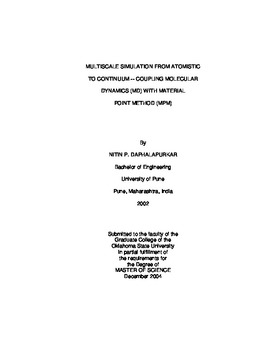| dc.contributor.author | Daphalapurkar, Nitin Pandurang | |
| dc.date.accessioned | 2014-04-17T19:52:13Z | |
| dc.date.available | 2014-04-17T19:52:13Z | |
| dc.date.issued | 2004-12-01 | |
| dc.identifier.uri | https://hdl.handle.net/11244/9916 | |
| dc.description.abstract | Failure in single crystals and polycrystalline materials usually involve processes such as dislocation, cleavage, macrocrack initiation and growth as well as coalescence until final fracture. Multiscale modeling is necessary to understand the mechanical behavior of materials from atomistic to continuum scales. MPM has been used for continuum simulation. The use of material points at the continuum level provides a natural connection with the atoms in the lattice at the atomistic scale. A hierarchical mesh refinement technique in MPM is presented to scale down the continuum level to the atomistic level, so that material points at the fine level in MPM are allowed to directly couple with the atoms in the MD. A one-to-one correspondence of MD atoms and MPM points is used in the transition region, and non-local elastic theory is used to assure compatibility between MD and MPM regions, so that seamless coupling between MD and MPM can be accomplished. A single crystal silicon workmaterial under uniaxial tension is used in demonstrating the viability of the technique. A Tersoff-type, three-body potential was used in the MD simulations. Further, elastic plastic constitutive material model is integrated with three-dimensional MPM to aid simulation of nanocrystalline material behavior at continuum scale. A new multiscale simulation approach is introduced that couples atomistic scale simulations using MD with continuum scale simulations using MPM. The coupled MD/MPM simulations show that the silicon under nanometric tension experiences with increasing elongation in elasticity, dislocation generation and plasticity by slip, void formation and propagation, formation of amorphous structure, necking, and final rupture. Results are presented in terms of stress - strain relationships at several strain rates, as well as the rate dependence of uniaxial material properties. This new multiscale computational method has potential for use in cases where a detailed atomistic-level analysis is necessary in localized spatially separated regions whereas continuum mechanics is adequate in rest of the material. | |
| dc.format | application/pdf | |
| dc.language | en_US | |
| dc.publisher | Oklahoma State University | |
| dc.rights | Copyright is held by the author who has granted the Oklahoma State University Library the non-exclusive right to share this material in its institutional repository. Contact Digital Library Services at lib-dls@okstate.edu or 405-744-9161 for the permission policy on the use, reproduction or distribution of this material. | |
| dc.title | Multiscale Simulation from Atomistic to Continuum -- Coupling Molecular Dynamics (MD) with Material Point Method (MPM) | |
| dc.type | text | |
| osu.filename | Daphalapurkar_okstate_0664M_1163.pdf | |
| osu.college | Engineering, Architecture, and Technology | |
| osu.accesstype | Open Access | |
| dc.description.department | Mechanical & Aerospace Engineering | |
| dc.type.genre | Thesis | |
| dc.subject.keywords | multiscale simulations | |
| dc.subject.keywords | atomistic/continuum coupling | |
| dc.subject.keywords | molecular dynamics | |
| dc.subject.keywords | material point method | |
| dc.subject.keywords | tensile testing | |
| dc.subject.keywords | single crystal silicon | |
